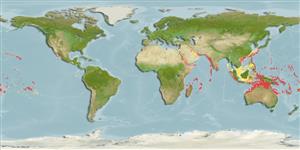Common names from other countries
Issue
Ref. 2334 explains the use of current genus name.
Environment: milieu / climate zone / depth range / distribution range
Ekologi
marina revassocierade; djupintervall 10 - 91 m (Ref. 26165), usually 10 - 60 m (Ref. 27115). Tropical; 22°C - 27°C (Ref. 27115); 32°N - 24°S
Indo-Pacific: East Africa to Samoa and the Line Islands (Ref. 2334), north to southern Japan, south to the Great Barrier Reef.
Size / Vikt / Age
Maturity: Lm ? range ? - ? cm
Max length : 14.0 cm TL hane/ej könsbestämd; (Ref. 2334); common length : 12.0 cm TL hane/ej könsbestämd; (Ref. 9137)
Taggstrålar i ryggfenan (totalt) : 10; Mjukstrålar i ryggfenan (totalt) : 15 - 17; Taggstrålar i analfenan: 3; Mjukstrålar i analfenan: 7 - 8. Males develop an incomplete crimson bar in the middle of their sides (Ref. 37816).
Mostly found on open substrate with low reef and remote bommies in depths over 20 m. Juveniles maybe shallow in coastal reefs (Ref. 48635). Form small, loose aggregations along current-swept drop-offs (Ref. 1602, 48635).
Life cycle and mating behavior
Maturities | Reproduktion | Spawnings | Egg(s) | Fecundities | Larver
Masuda, H. and G.R. Allen, 1993. Meeresfische der Welt - Groß-Indopazifische Region. Tetra Verlag, Herrenteich, Melle. 528 p. (Ref. 9137)
IUCN Red List Status (Ref. 130435)
CITES (Ref. 128078)
Not Evaluated
Threat to humans
Harmless
Human uses
Fiskeri: kommersiell; Akvarium: Offentliga akvarier
Verktyg
Special reports
Download XML
Internet-källor
Estimates based on models
Preferred temperature (Ref.
115969): 24.8 - 28.8, mean 27.6 (based on 990 cells).
Phylogenetic diversity index (Ref.
82804): PD
50 = 0.5000 [Uniqueness, from 0.5 = low to 2.0 = high].
Trofisk nivå (Ref.
69278): 3.4 ±0.45 se; based on food items.
Resiliens (Ref.
120179): Hög, lägsta populationsfördubblingstid mindre än 15 månader (Preliminary K or Fecundity.).
Fishing Vulnerability (Ref.
59153): Low vulnerability (10 of 100).
